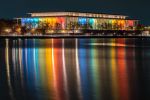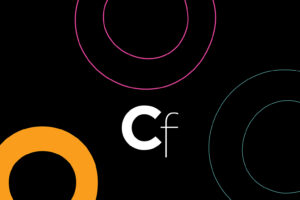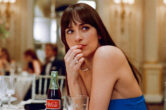Who Was Ching Ho Cheng and Why Was He So Important?

Ching Ho Cheng used to say he was working with paper, instead of on it. Forever experimenting, the Chinese-American artist (1946–89) created spiritual works from his home studio in Suite 903 of New York’s Chelsea Hotel, constantly playing with these humble sheets. “Paper breathes,” Cheng explained. “So I prefer to say that I work with paper.”
His collaboration with paper took many forms. Cheng’s early works, in the late 1960s and early 1970s, were at first psychedelic, then realistic and two-dimensional. He then experimented with torn-paper works, and by the end of his career (cut short due to his death from AIDS-related complications) his pieces were monumental, oxidized, and sculptural.
A selection of his airbrushed gouache works from the mid to late 1970s, of sunlight pouring through his apartment’s windows and onto its walls, are now on view in a solo show at Bank gallery’s New York outpost. Cheng made these transitional works after a period of deeply detailed compositions and before his more minimalist works, but they’re all tied together by themes of impermanence and transience. Here, he was also trying to depict illumination. “Through his delicate work you are able to perceive a cosmic infinity,” says Bank gallery founder Mathieu Borysevicz.

Ching Ho Cheng, Untitled, 1978
Photo: Inna Svyatsky. Courtesy of the Ching Ho Cheng Estate.
Indeed, the current show is part of a revival of interest in Cheng’s work. Apart from his current solo show, on view through June 14, the Shanghai-based Bank gallery presented Cheng’s work at Art Basel Miami Beach in 2023 and Art Basel Hong Kong last year. He also had a solo presentation at David Zwirner’s New York location in the autumn of 2021. His papers and artifacts held at the Smithsonian Archives of American Art were digitized in 2024, making it easier to access materials such as his sketchbooks, photographs, and correspondence.
Cheng’s work was shown and collected in his lifetime by institutions such as the Hirshhorn Museum and Sculpture Garden, Cleveland Museum of Art, Brooklyn Museum, and NYU’s Grey Art Museum. Since his death at age 42, his legacy and estate have been stewarded by his sister, Sybao Cheng-Wilson (who now lives in her brother’s Chelsea Hotel apartment). Still, Cheng is not as well known as some of his contemporaries. Part of the reason is that he didn’t have an easily identifiable signature style. He was also out of sync with the movements of his time, for example working in gouache at a time when conceptual art was king.

Ching Ho Cheng, The Astral Theatre (Study), 1972
Photo: Gustavo Murillo. Courtesy of the Ching Ho Cheng Estate..
Cheng’s work will also be included in the “Sixties Surreal” group show opening this fall at the Whitney Museum of American Art (which has four of his works in its collection), and he will have his first major institutional retrospective at the Addison Gallery of American Art in Andover, Massachusetts, in early 2027. Coinciding with the retrospective, the Addison and Visual AIDS will also be co-publishing a monograph on Cheng. “I believe that [this retrospective] will launch a watershed moment in terms of interest in the work and life of Cheng,” says Borysevicz.
Cheng was born in Havana to Chinese parents while his father was a diplomat for Chiang Kai Shek’s government. After the Chinese Revolution the family moved to Queens, New York, where Cheng grew up. The artist’s earliest works were intricate psychedelic paintings, inspired by Taoist teachings about life and death cycles as well as Tibetan tantric art. These works, sometimes large scale, were painstakingly created over long periods and included details such as flames, tubular forms, orbs, sperm, teeth, and lips.

Ching Ho Cheng, Strike (Match Series), 1978
Photo: Gustavo Murillo. Courtesy of the Ching Ho Cheng Estate.
After a few years, Cheng moved on to hyper-realistically painted domestic scenes and everyday objects such as lightbulbs, cigarette butts, and beer cans.“He would take something very mundane and make it sacred,” the artist’s sister, Cheng-Wilson, shared in a recent panel talk at Bank gallery. “That was his point.”
One of his better-known works from this period, Waterfall, Chelsea Hotel, New York (1978), depicts his own bubblegum-pink shower wall covered with water droplets, with peeling paint above symbolizing disintegration and decay. A detail you could almost miss in all the pink is a single hair on one of the tiles, rife with potential for narrative. “Cheng would often hide something very personal in his artwork,” Cheng-Wilson said. “He painted one little black hair of [his lover] Gregory Millard’s, or he would put his thumbprint. Sometimes you wouldn’t see it, but he knew it was there.”

Ching Ho Cheng, Waterfall, Chelsea Hotel, New York, 1978
Photo: Gustavo Murillo. Courtesy of the Ching Ho Cheng estate.
After moving through the psychedelics and the domestic scenes, Cheng started working on the airbrushed gouach paintings, exploring the effect of light and shadows so realistically that viewers weren’t sure if they were real or painted. He had an “ability to take these things that we wouldn’t necessarily focus on and to really live with, engage with the shadow in this profound way and to render, with such care, every peeling bit of paint, every dent in the wall,” observes Gordon Wilkins, curator of American art at the Addison and of the museum’s upcoming Cheng retrospective.
After these shadow paintings, Cheng shifted to torn-paper works, which grew from his tendency to destroy artworks he was unhappy with. Looking at these destroyed works anew, he came to view tearing as a “spontaneous gesture which can never be exactly duplicated,” he later noted. The torn works coincided with a time when he was mourning many friends lost to the AIDS epidemic, and often included blue and green, which he viewed as symbolic of rebirth.

Ching Ho Cheng, Untitled (Study for Grotto), 1987
Photo: Gustavo Murillo, Courtesy of the Ching Ho Cheng estate.
Cheng’s final body of work, in the late 1980s, were “alchemical” pieces that he made by soaking rag paper in water for days or weeks, adding acrylic paint and gesso to harden it. This transformed the paper into sculptural, three-dimensional forms that he molded into organic shapes. He’d then add copper or iron dust, which oxidized when put back in the water. This phase culminated in Cheng’s last major work, The Grotto (1987)—seven panels creating a 10-foot-tall arc spanning 25 feet, with textures and earthy tones that resembled caves he’d seen while traveling in Turkey. Originally installed at the Grey Art Gallery in 1987, it will be on view in the upcoming Addison retrospective.
Each of Cheng’s four phases may seem self-contained, but to him they were all connected. “My work all says the same thing; I only keep trying to say it in a new way, a way it was never said before,” said Cheng. “None of it is really new, however; they’ve said it again and again, and it’s as old as the hills. All I can claim is that mine is a way of seeing I’ve never encountered anywhere else.”

Ching Ho Cheng, Untitled, 1982
Photo: Gustavo Murillo. Courtesy of the Ching Ho Cheng Estate.




